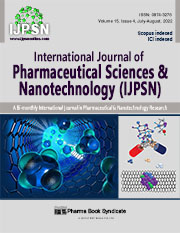Facile Characterization of Titanium Dioxide Nano- particles Prepared via Hydrothermal Method with in-situ Surface Modification
DOI:
https://doi.org/10.37285/ijpsn.2022.15.4.3Abstract
Aim: The present study is focused on the synthesis and characterization of titanium dioxide nanoparticles prepared via the hydrothermal method prepared via in-situ surface modification.
Purpose of the study: The proposed research is based on the requirement of alternate antimicrobial therapies. The global misuse and overuse of antibiotics have given rise to the antibiotic resistance crisis. The emergence of multi-drug resistant bacteria has failed the conventional treatment methods involving antibiotics. To meet the need for efficient alternate strategies, metal oxide nanoparticles such as titanium dioxide are explored since it's known for their preventing and treating infections.
Method: Titanium dioxide nanoparticles were successfully synthesized via hydrothermal and Surface modification of nanoparticles in dehydrated ethanol at room temperature. The obtained nanoparticles are characterized by utilizing Scanning Electron Microscope, Transmission Electron Microscope, Energy Dispersive X-ray Spectroscopy, Zeta Potential Analysis, Thermogravimetric analysis, and Fourier transform Infrared spectroscopy.
Results: According to scanning electron microscopy and transmission electron microscopy, the morphological analysis of the synthesized titanium dioxide was spherical shaped and had an average size of 5-20nm and a size distribution of 14-20nm. The Energy Dispersive X-ray spectroscopy analysis depicted the percentage of elements in TiO2 as Ti (47.10%) and O2 (52.90%). The zeta potential for titanium dioxide was reported as -13.39, and the negative value indicated superior physical stability of nanoparticles in a suspension. The Fourier Transform Infrared spectroscopy peak at 1417.68 indicated the O-Ti-O bond in anatase morphology. While Thermogravimetric analysis showed three main stages of mass loss, there was no mass loss after 503°C, which started oxide formation.
Conclusion: It was concluded from the present study that the synthesis of titanium dioxide is an economical process and yields excellent nanoparticles via the hydrothermal method. Characterization of the nanomaterial allowed us to determine the thermal stability, morphology, and purity of titanium dioxide nanoparticles.
Downloads
Metrics
Keywords:
Hydrothermal method, Thermogravimetric analysis (TGA), FTIR, Surface modified TiO2 nanoparticlesDownloads
Published
How to Cite
Issue
Section
References
Alhadrami HA, Badari A, Iqbal J, Shoudri RAM (2017). Antibacterial application of Anatase TiO2 nanoparticles. American Journal of Nanomaterials. 5(1):31-42.
Aruoja V, Dubourguier HC, Kasemets K, Kahru A (2009). Toxicity of Nanoparticles of CuO, ZnO, and TiO2 to microalgae Pseudokirchneriella subcapitata. Science Of The Total Environment. 407:1461-8.
Finland M, Kirby WM, Chabbert YA, Chain EB, Dowling HF, Garrod LP, Pettinga CW. and Todd AC. (1965) Round table: are new antibiotics needed? Antimicrob Agents Chemother (Bethesda) 5:1107-1114.
He F, Yu W, Fan X, Jin B (2017). In-vitro cytotoxicity of Biosynthesized titanium dioxide nanoparticles in human prostate cancer cell lines. Tropical Journal of Pharmaceutical Research. 16(12):2793-2799.
Hsiao IL and Huang YJ (2011). Effect of various physicochemical characteristics on the toxicities of ZnO and TiO2 nanoparticles towards human lung epithelial cells. Science of the Total Environment. 409:1219-1228.
Hui P, Xiaodong W, Shasha X, Laigui Y, and Xinjun X, (2013), Preparation and characterization of TiO2 nanoparticles surface modified by octadecyltrimethoxysilane. Indian journal of engineering and material sciences. 20:561-567.
Liao DL, Wu GS, Liao BQ (2009). Zeta potential of shape-controlled TiO2 nanoparticles with surfactants. Colloids and Surfaces: A Physiochemical and Engineering Aspects. 348(1-3):270-275.
Liu Z, Wang R, Kan F, Jiang F (2014). Synthesis and characterization of TiO2 nanoparticles. Asian Journal of Chemistry. 26(3):655-659.
Nakayama N and Hayashi T (2007). Preparation and characterization of TiO2 and polymer nanocomposite films with high refractive index. Journal of Applied Polymer Science. 105: 3662-3672.
Pan H, Wang XD, Xiao S, Yu L and Zhang Z (2013). Preparation and characterization of TiO2 nanoparticles surface modified by octadecyl-trimethoxysilane. Indian Journal of Engineering and Material sciences. 20:561-567.
Rajendran V and Vijayalakshmi R. (2012) Synthesis and characterization of nano- TiO2 via different methods. The architecture of applied science research. 4(2):1183-1190.
Safaei E, Mohebbi S, Irani M (2018). Selective aerobic photocatalytic oxidation of benzyl alcohol over spherical structured WO3/TiO2 nanocomposite under visible light irradiation. Journal of Sol-gel Science and Technology. 87:170-182.
Santhi K, Harish S, Navneetham M, Ponnusamy S (2021). Investigation of metal-doped mesoporous TiO2 nanostructures. Environmental Reme-diation. 10:1-15.
Sharma A, Goyal AK, Rath G. (2018) Recent Advances in metal nanoparticles in cancer therapy. Journal of Drug Targeting. 26(8):617-632.
Xia T, Kovochich M, Nel AE (2007) Impairment of mitochondrial function by particulate matter (PM) and their toxic components: Implications of PM induced cardiovascular and lung disease. Frontier Biosciences.;12:12.
Yao C, Gao GS, Lin XP, Yang XJ, Lu LD and Wang X (2006). Surface modification of nanosized TiO2 with silane coupling reagent. Journal of Inorganic Materials. 21(2):315-321.
Zhau H, Sia S,and Ding Hao (2017). Surface organic modification of TiO2 powder and relevant characterization. Advances in Material Sciences and Engineering. 9562612.
Zoccal JVM, Arouca FDO, Goncalves JAS. Synthesis and characterization of TiO2 nanoparticles by method pechini. Seventh International Latin American Conference on Powder technology. 449-455.






